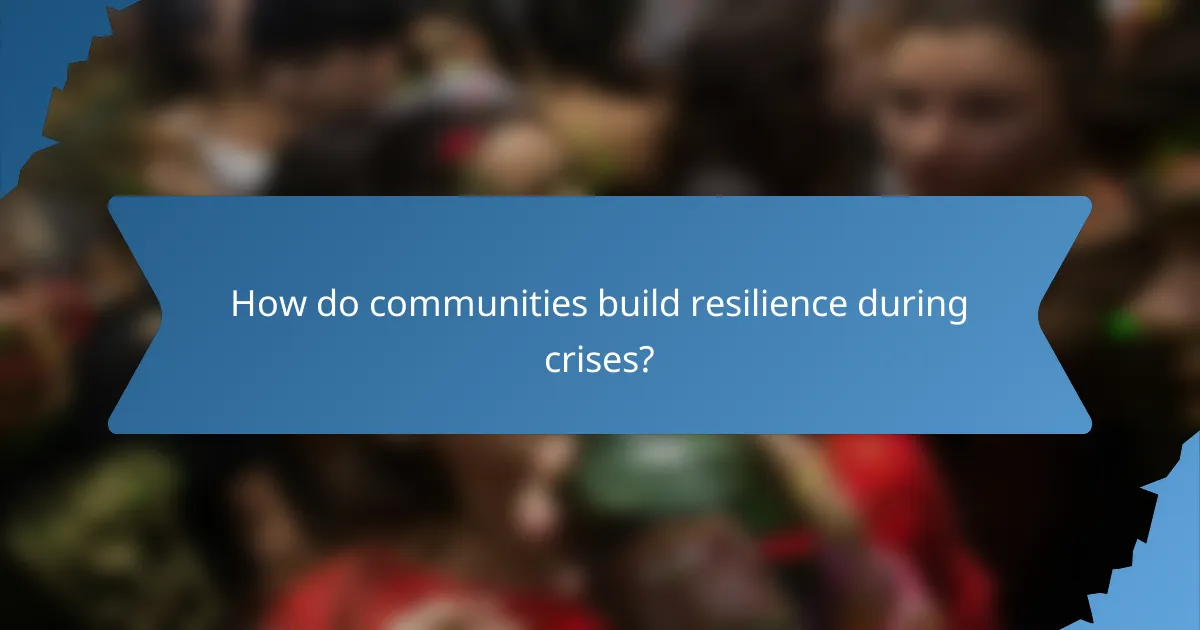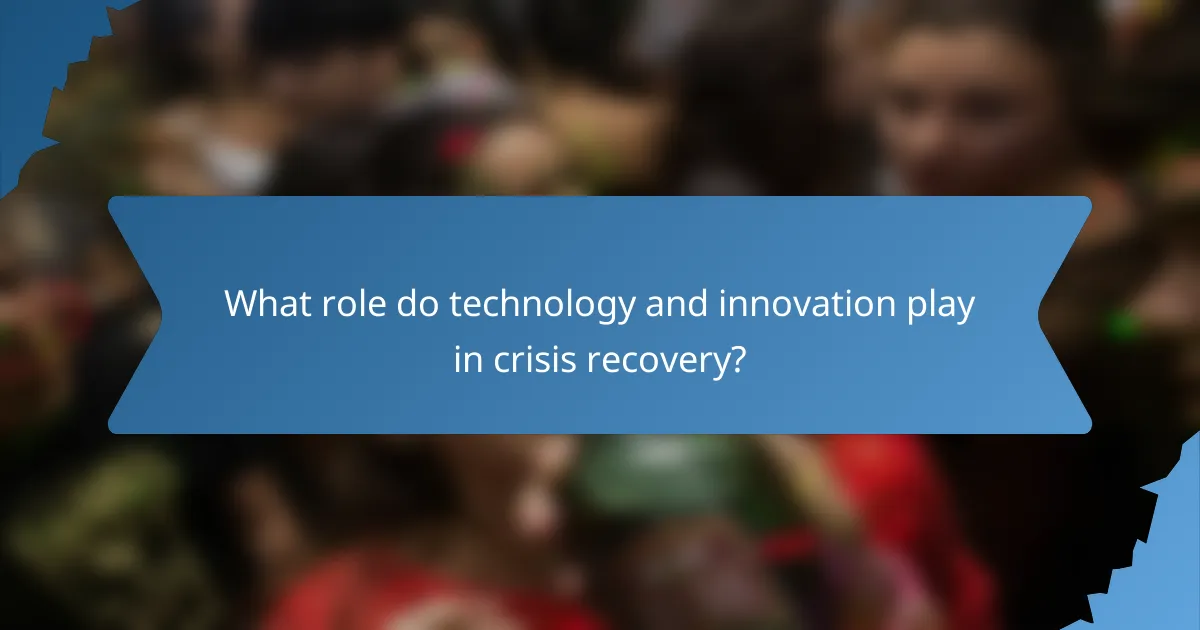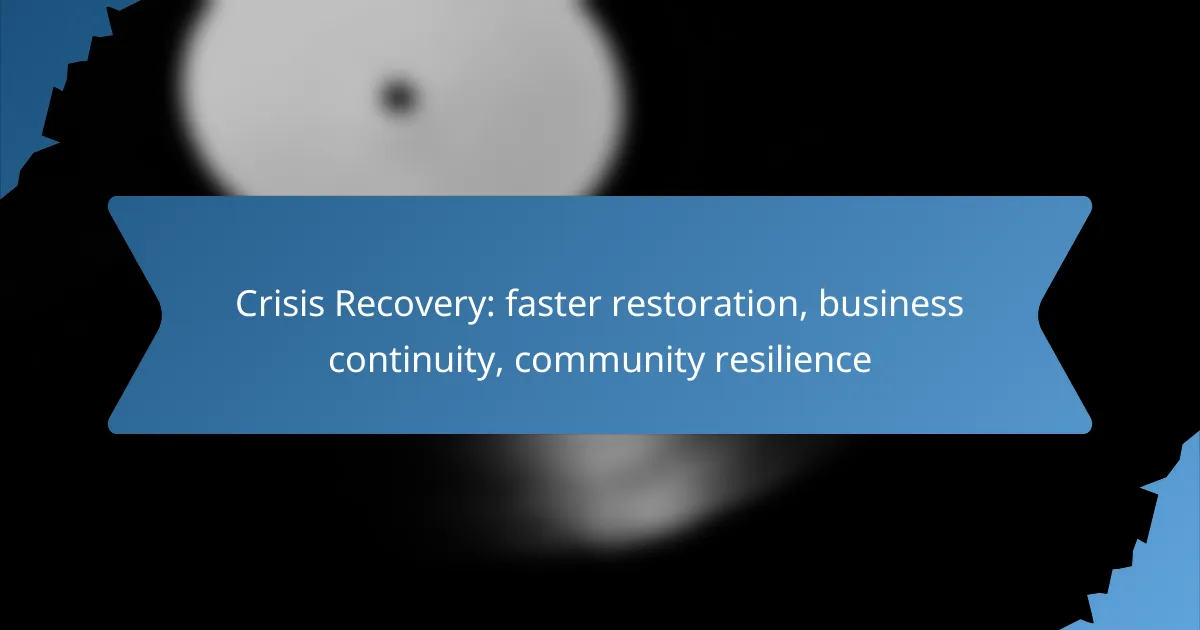Crisis recovery is essential for businesses and communities alike, enabling faster restoration and continuity in the face of disruptions. By developing comprehensive disaster recovery plans, leveraging technology, and fostering strong local relationships, organizations can enhance their resilience. Additionally, proactive planning and effective communication within communities are vital for building the capacity to withstand and recover from crises.

How can businesses in Canada achieve faster crisis recovery?
Businesses in Canada can achieve faster crisis recovery by developing comprehensive disaster recovery plans, leveraging technology, and fostering strong relationships with local emergency services. These strategies enhance resilience, ensuring continuity and quicker restoration of operations after a crisis.
Implementing disaster recovery plans
Establishing a disaster recovery plan is essential for any business aiming for rapid recovery. This plan should outline procedures for data backup, resource allocation, and communication during a crisis. Regularly reviewing and updating the plan ensures it remains relevant and effective.
Key components of a disaster recovery plan include identifying critical business functions, assessing potential risks, and creating a clear response strategy. Businesses should also designate a recovery team responsible for executing the plan and communicating with stakeholders.
Utilizing cloud-based solutions
Cloud-based solutions can significantly enhance a business’s ability to recover quickly from a crisis. These solutions offer scalable resources, enabling businesses to access data and applications from anywhere, which is crucial during disruptions. Adopting cloud services can reduce downtime and improve operational flexibility.
When selecting cloud solutions, consider factors like data security, compliance with Canadian regulations, and the provider’s reliability. Many businesses opt for hybrid cloud models, combining on-premises infrastructure with cloud services to balance control and scalability.
Engaging with local emergency services
Building strong relationships with local emergency services is vital for effective crisis recovery. Engaging with these services can provide businesses with valuable insights into emergency protocols and resources available during a crisis. Regular communication can facilitate quicker response times and coordinated efforts during emergencies.
Participating in community preparedness initiatives and attending local emergency planning meetings can enhance collaboration. Businesses should also ensure that emergency services are aware of their specific needs and vulnerabilities, enabling tailored support during a crisis.
Conducting regular training and drills
Regular training and drills are crucial for ensuring that employees are prepared to respond effectively during a crisis. These exercises help familiarize staff with the disaster recovery plan and identify any weaknesses in the procedures. Conducting drills at least once or twice a year can reinforce readiness and improve response times.
Consider varying the scenarios in training sessions to cover different types of crises, such as natural disasters or cyberattacks. After each drill, gather feedback from participants to refine the recovery plan and address any gaps in knowledge or resources.

What strategies enhance business continuity in Canada?
Strategies that enhance business continuity in Canada focus on proactive planning, effective communication, and robust systems. Implementing these strategies helps organizations maintain operations during disruptions and recover more swiftly.
Developing a business continuity plan
A business continuity plan (BCP) outlines how an organization will continue operations during and after a crisis. Key components include risk assessment, recovery strategies, and roles and responsibilities. Regularly updating the BCP ensures it remains relevant to changing circumstances.
Consider conducting drills to test the plan’s effectiveness and identify areas for improvement. Engaging employees in the planning process can also enhance buy-in and awareness of their roles during a crisis.
Establishing communication protocols
Effective communication protocols are essential for maintaining business continuity. These protocols should specify how information will be shared internally and externally during a crisis. Clear guidelines help ensure that all stakeholders receive timely updates and instructions.
Utilizing multiple communication channels, such as emails, text alerts, and social media, can enhance reach and effectiveness. Regularly reviewing and practicing these protocols can help prevent confusion when a crisis occurs.
Investing in redundancy systems
Redundancy systems provide backup resources to ensure operations can continue during disruptions. This may include data backups, alternative power sources, and duplicate suppliers. Investing in these systems can significantly reduce downtime and financial losses.
When selecting redundancy solutions, consider the specific needs of your business and the potential risks you face. Regularly testing these systems is crucial to ensure they function correctly when needed.

How do communities build resilience during crises?
Communities build resilience during crises by fostering collaboration, enhancing preparedness, and ensuring effective response mechanisms. This involves engaging local members, creating structured teams, and improving infrastructure to withstand and recover from adverse events.
Fostering community engagement programs
Community engagement programs are essential for building resilience as they encourage participation and collaboration among residents. These programs can include workshops, training sessions, and social events that raise awareness about crisis preparedness and response.
To be effective, these initiatives should focus on inclusivity, ensuring that all demographics are represented. For example, organizing neighborhood meetings can help gather input from diverse groups, fostering a sense of ownership and responsibility.
Creating local emergency response teams
Establishing local emergency response teams is crucial for effective crisis management. These teams, composed of trained volunteers, can provide immediate assistance during disasters, such as first aid, search and rescue, and communication with authorities.
Communities should prioritize training for these teams, which can include basic emergency response skills and regular drills. Collaborating with local authorities can enhance their effectiveness, ensuring they operate within established guidelines and protocols.
Enhancing infrastructure for disaster preparedness
Improving infrastructure is vital for disaster preparedness and community resilience. This can involve upgrading roads, bridges, and public buildings to withstand natural disasters, as well as ensuring access to essential services like water and electricity during emergencies.
Communities should assess their current infrastructure and identify vulnerabilities. Investing in resilient designs, such as flood barriers or earthquake-resistant structures, can significantly reduce damage and speed up recovery efforts. Regular maintenance and updates to infrastructure are also critical to ensure ongoing effectiveness.

What role do technology and innovation play in crisis recovery?
Technology and innovation are crucial in crisis recovery as they enhance the speed and effectiveness of restoration efforts. By leveraging advanced tools, organizations can ensure business continuity and strengthen community resilience during and after a crisis.
Leveraging AI for predictive analytics
AI-driven predictive analytics can significantly improve crisis recovery by forecasting potential disruptions and enabling proactive measures. Organizations can analyze historical data and real-time information to identify patterns and anticipate future challenges, allowing for timely interventions.
For example, businesses can use AI to predict supply chain disruptions, enabling them to adjust inventory levels or find alternative suppliers. This foresight can reduce downtime and maintain service delivery, which is essential for customer retention and overall stability.
Using mobile apps for crisis communication
Mobile apps play a vital role in crisis communication by providing real-time updates and facilitating information sharing among stakeholders. These applications can help organizations disseminate critical information quickly, ensuring that employees and community members are informed and can respond effectively.
Implementing a mobile app for crisis communication should focus on user-friendly design and accessibility. Features like push notifications, emergency contact lists, and resource directories can enhance user engagement and ensure that vital information reaches the intended audience without delay.

What are the key criteria for selecting crisis recovery solutions?
Key criteria for selecting crisis recovery solutions include scalability, cost-effectiveness, and the ability to maintain business continuity. These factors ensure that organizations can efficiently recover from disruptions while minimizing financial impacts and supporting community resilience.
Assessing scalability of solutions
Scalability refers to a solution’s ability to adapt and grow according to the needs of the organization during a crisis. When evaluating scalability, consider whether the solution can handle increased demand without significant delays or additional costs.
For instance, cloud-based recovery services often provide flexible resources that can be adjusted based on real-time requirements. Organizations should assess whether the chosen solution can seamlessly expand or contract, ensuring it remains effective during both minor disruptions and major crises.
Evaluating cost-effectiveness
Cost-effectiveness involves analyzing the financial implications of crisis recovery solutions relative to their benefits. Organizations should consider both upfront costs and ongoing expenses, such as maintenance and support, to determine the overall value of a solution.
For example, a solution that requires a high initial investment but significantly reduces downtime may be more cost-effective in the long run compared to a cheaper alternative that leads to prolonged disruptions. It’s essential to conduct a thorough cost-benefit analysis, factoring in potential losses from business interruptions and the value of maintaining customer trust.

How can businesses measure the effectiveness of their recovery efforts?
Businesses can measure the effectiveness of their recovery efforts by evaluating key performance indicators (KPIs) such as recovery time objectives (RTOs) and recovery point objectives (RPOs). These metrics help organizations assess how quickly they can restore operations and data after a disruption, ensuring business continuity and community resilience.
Tracking recovery time objectives
Recovery time objectives (RTOs) define the maximum acceptable duration for restoring business operations after a crisis. To effectively track RTOs, businesses should establish clear timelines for each critical function and regularly test their recovery plans to ensure they can meet these targets.
Consider categorizing functions based on their importance to the business. For instance, essential operations may require RTOs of just a few hours, while less critical tasks could have RTOs extending to several days. This prioritization helps allocate resources efficiently during recovery efforts.
Regularly reviewing and updating RTOs is crucial. Factors such as changes in technology, business processes, or market conditions can impact recovery capabilities. Conducting drills and simulations can provide insights into potential bottlenecks and areas for improvement, ensuring that the organization remains prepared for future disruptions.
